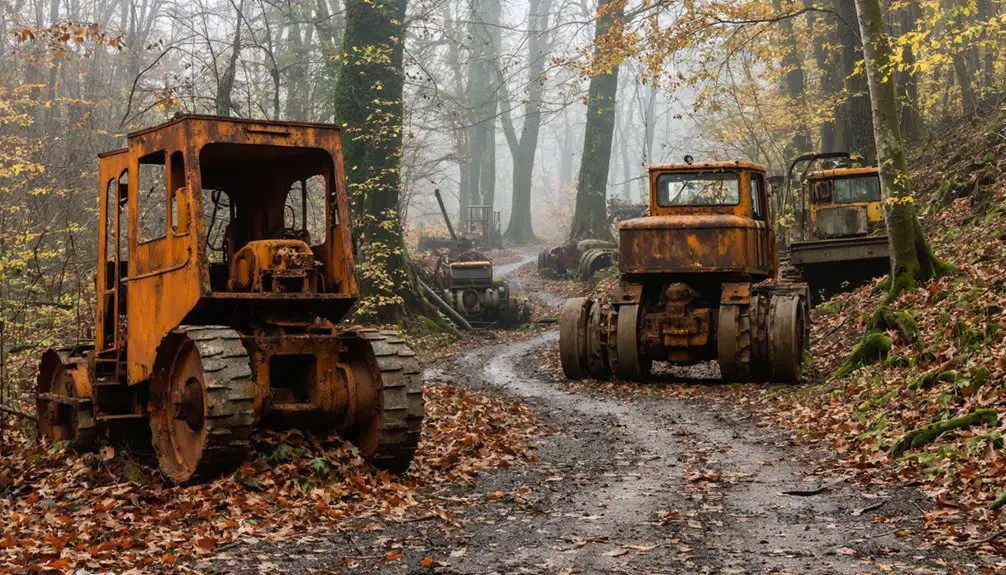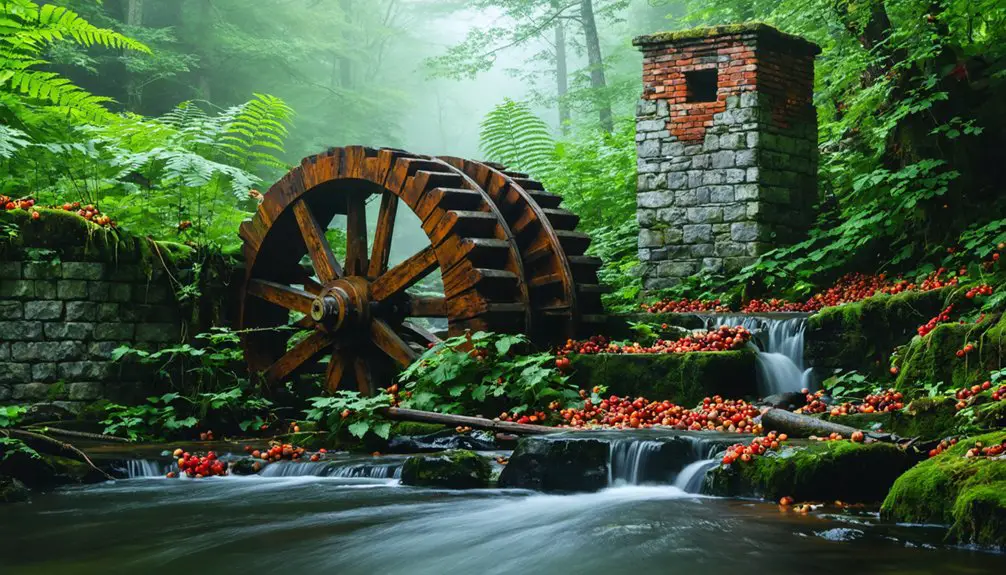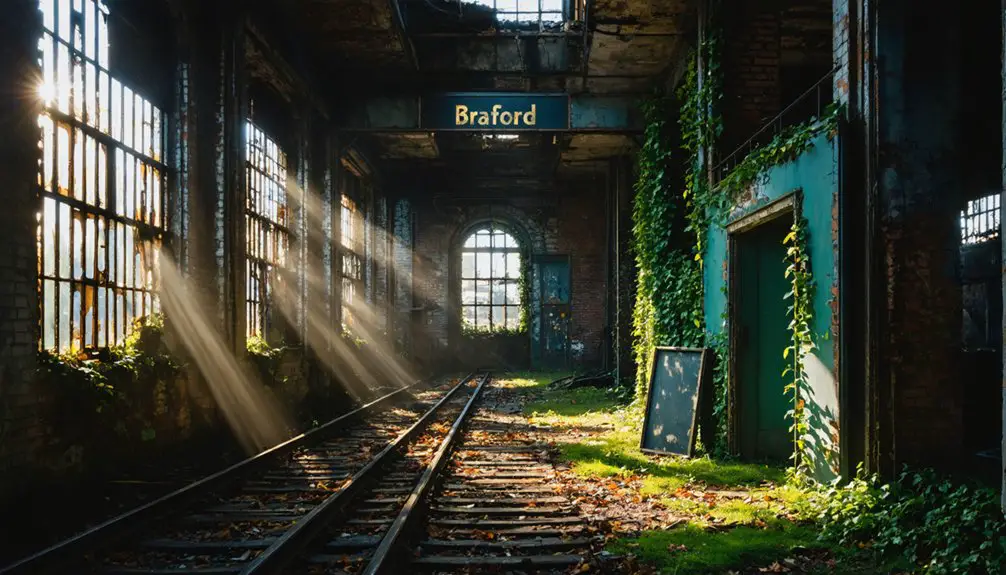You’ll find Rhode Island’s Whipple ghost town centered around abandoned marble quarries that operated from the early 1800s until 1938. The settlement, established by John Whipple’s family in 1658, thrived as a quarrying community until labor disputes, accidents, and reported supernatural occurrences drove residents away. The area now features crumbling foundations, flooded quarry pits, and the historic Whipple-Jenckes House. Local folklore and archaeological evidence reveal a deeper story of this once-bustling New England settlement.
Key Takeaways
- The Whipple-Jenckes House stands abandoned at Diamond Hill and Fairhaven Roads, marking the remnants of early Rhode Island settlement.
- Hidden cellar foundations and stone steps throughout mixed hardwood forests reveal the forgotten colonial settlement’s former extent.
- Archaeological remains, including an intact well and stone foundations, provide evidence of colonial New England life in Whipple.
- The area contains abandoned quarries with unstable chambers and stagnant water, contributing to the ghost town’s dangerous atmosphere.
- Local folklore, including ghost sightings and supernatural tales, has preserved the memory of this former settlement since 1938.
Origins of Whipple’s First Settlers
While many early New England settlements trace their roots to multiple founding families, the town of Whipple began distinctly with John Whipple’s arrival aboard the Lyon in 1631.
At just 15 years old, you’ll find that young Whipple’s settler motivations initially centered on learning his trade as a carpenter under Israel Stoughton in Dorchester. He wasn’t alone in facing colonial challenges – he arrived with 122 others, including prominent figures Roger Williams and John Eliot.
By the late 1630s, Whipple had married Sarah and established himself in Dorchester’s religious community. Their growing family of eleven children and his 1637 land grant near Indian territories showed his dedication to building a permanent life. His expertise as a housewright and bridge builder proved invaluable to the developing settlement. After two decades of growth in Dorchester, he sold his homestead and relocated to Providence in 1658.
You can trace his ambition further as he later sought new opportunities in Providence, Rhode Island.
Life in the Shadow of the Marble Quarries
You’ll find that daily life for Whipple’s quarry workers was marked by constant physical demands, from manual drilling to operating heavy machinery in treacherous conditions.
Your ancestors who worked these quarries faced not only the immediate dangers of falling stone and equipment accidents but also the long-term health impacts of marble dust and exhaustion that came with 12-hour workdays.
While company benefits like accident insurance and medical care offered some protection, the strikes of 1859 revealed the deeper struggles of workers fighting for fair wages and safer conditions in these challenging underground workplaces.
The Vermont Marble Company took control of operations in the area after the True Blue Marble Company’s tenure, continuing the region’s rich quarrying legacy.
The region’s numerous streams and rivers provided essential water power to support the quarrying operations and manufacturing activities in the area.
Quarry Workers’ Daily Struggles
Deep in the marble quarries of Whipple, workers faced grueling daily struggles that shaped both their work and home lives.
You’d find them enduring harsh quarry conditions – battling intense physical demands while operating steam-powered jackhammers and hauling massive stone blocks through dust-filled air and extreme weather. Their lungs filled with marble particles as they drilled and cut for long hours under dangerous circumstances.
Labor disputes erupted as workers fought for better wages and shorter workdays, but company control ran deep. If you joined a strike, you’d risk losing not just your job but your company-owned home. Following the example of Rogerine Quakers, some workers began organizing peaceful protests against harsh working conditions.
When French Canadian immigrants replaced local strikers in 1868, the tensions only grew. The introduction of mechanized tools brought efficiency but also new hazards and conflicts between traditional laborers and modern machinery. The area’s development accelerated after the Great Road opened in 1683, bringing more workers to the quarries.
Hidden Dangers Below Ground
The abandoned marble quarries of Whipple harbor deadly secrets beneath the surface, creating a silent threat to the surrounding community.
You’ll find a web of unstable underground chambers where decades of excavation have left the ground prone to sudden collapse. The hidden hazards don’t stop at structural instability – stagnant water pools in these voids, while toxic chemicals from old mining operations seep into the groundwater. The nearly dozen deaths in local quarries over the past decade serve as a grim reminder of these dangers.
Underground dangers multiply as seasonal flooding weakens quarry walls and historic mining equipment rusts away.
- Vast networks of unmapped tunnels create treacherous mazes
- Ground collapse can occur without warning due to eroded support structures
- Contaminated groundwater poses risks to local water supplies
- Flash flooding threatens anyone venturing into quarry chambers
- Decaying industrial equipment creates deadly traps in dark passages
The Tragic Tale of John Copt
Arriving aboard the ship Lyon in 1632, John Copt established himself as a pivotal figure in colonial Providence’s early development, though historical records often confuse his legacy with other settlers sharing similar names.
You’ll find his impact most visible through his prominent tavern, which became Providence’s central meeting place for town councils in 1669-1670. As treasurer, surveyor, and selectman, he shaped the community’s growth while serving seven terms as deputy to the General Assembly. Originally working as a house-carpenter in Massachusetts, he brought valuable construction skills to the settlement.
During King Philip’s War, when most fled Providence, Copt stood his ground. This decision earned him both respect and controversy, as he later received Indian captives as slaves – a dark reminder of colonial practices. He witnessed the devastating destruction of Warwick and Pawtuxet during the conflict.
His death in 1685 left a complex legacy: a successful businessman, civic leader, and survivor whose story reflects both the triumphs and moral challenges of early colonial life.
Haunting Legends Through the Years
Since the first documented ghost sighting in 1938, Whipple Hollow‘s haunting legends have centered around a mysterious white apparition near the abandoned quarry.
You’ll find countless paranormal evidence in modern YouTube videos and local accounts, describing a wispy figure that drifts through the area. The stories have evolved from newspaper reports to digital folklore, keeping the haunting’s legacy alive for nearly a century.
From vintage newspaper clippings to viral ghost videos, Whipple Hollow’s ethereal visitor continues captivating believers and skeptics alike.
The Stone Tape Theory suggests the area’s granite quarries may amplify supernatural activity through stone’s ability to record energetic events.
- Quarry worker’s initial 1938 sighting sparked widespread media attention
- Ghost appears as a cloudy, mist-like form near Whipple Hollow Road
- Many connect the apparition to John Copt’s tragic 1874 suicide
- Local community preserves the tale through generational storytelling
- Digital platforms now document new ghost sightings and experiences
Geographic Features and Natural Landmarks

Nestled in northwestern Rhode Island’s glacially carved landscape, Whipple’s geographic features tell a story of colonial adaptation and natural beauty.
You’ll find the historic Whipple-Jenckes House at the intersection of Diamond Hill and Fairhaven Roads, where stone walls mark the boundaries of this colonial settlement.
The area’s natural landmarks include rocky precipices like “Noforce Rocks” and wooded hillsides that characterize the rugged terrain.
Deep in the woods, you’ll discover remnants of early water management systems – ancient wells and a dam that once supported colonial farming operations.
The mixed hardwood forests conceal historic cellar foundations and stone steps, while the rocky farmland reveals the challenging conditions early settlers faced.
These geographic features paint a vivid picture of how colonists shaped this untamed landscape into a sustainable settlement.
The Legacy of the Whipple Family Name
You’ll find the Whipple family’s roots deeply embedded in Rhode Island’s colonial history, starting with John Whipple’s arrival in Providence during the 1600s where he established himself as a prominent civic leader and landowner.
Through strategic land management and civic engagement, your ancestors transformed the region through agricultural development and political leadership, with Thomas Whipple later serving as lieutenant governor in 1849.
Today, the Whipple surname carries significant weight in Rhode Island’s genealogical records, with over 73 direct descendants from John’s offspring establishing lasting familial connections throughout the region.
Early Colonial Settlement Origins
The legacy of Whipple, Rhode Island traces back to November 3, 1631, when 15-year-old John Whipple arrived aboard the ship Lyon alongside notable figures Roger Williams and John Eliot.
Through early settler experiences, you’ll find Whipple’s path from carpenter to landowner reflects the colonial challenges of establishing new communities. His journey from Dorchester to Providence embodies the spirit of freedom and opportunity that defined early American settlement.
- Worked as a carpenter for Israel Stoughton’s mill in Dorchester
- Married Sarah and raised eleven children while building community ties
- Joined Providence’s growing settlement in 1658, seeking new opportunities
- Secured land grants in Louisquisset by 1660
- Maintained relationships with both settlers and indigenous peoples, facilitating stable settlement
Agricultural Roots and Heritage
As John Whipple’s early settlement efforts took root, his descendants transformed the Rhode Island landscape through generations of agricultural innovation and land stewardship.
Their agricultural practices expanded from Captain John’s initial 40-acre plot to encompass diverse farming operations across multiple states. You’ll find evidence of their pioneering spirit in the Whipple Inn, which served as both homestead and community hub amid their flourishing farmlands.
The family’s land management showcased remarkable versatility, combining crop cultivation with livestock operations.
From Rhode Island’s colonial fields to Georgia’s cotton plantations, Whipple farmers produced impressive yields – up to 3,000 bushels of corn annually.
Their agricultural legacy intertwined with mercantile ventures, demonstrating how farming excellence could build both economic power and social influence in early America.
Genealogical Legacy Today
Since John Whipple’s arrival in colonial America, meticulous genealogical records have preserved his family’s expansive legacy across generations. Through family documentation compiled by Henry E. Whipple and countless others, you’ll find over 3,000 documented descendants spreading from Rhode Island across New England and beyond.
These genealogical connections tell a story of freedom, migration, and lasting impact that continues to shape communities today.
- Original burial sites and tombstones provide tangible links to your ancestral past
- Marriage records reveal connections to prominent Rhode Island families like Olney and Angell
- Collaborative genealogy platforms maintain active research with 49+ family historians
- Land records and wills document the transfer of property through generations
- Church membership records trace community integration and religious ties
Archaeological Remnants and Forgotten Ruins
Tucked away in Rhode Island’s dense woodlands, archaeological remnants of Whipple Hollow reveal a fascinating glimpse into colonial New England life through its stone foundations and structural ruins.
The forgotten structures tell a story of self-reliance, with stone cellars beneath kitchen spaces and a distinctive corn crib foundation highlighting the settlement’s agricultural roots.
Stone foundations whisper tales of colonial self-sufficiency, where kitchen cellars and corn cribs once sustained a determined farming community.
You’ll find an intact well that’s become a focal point for local folklore, while the archaeological significance of the site is amplified by the early 1800s abandonment, confirmed through tree growth analysis within the foundation holes.
Simon Whipple’s gravesite on the outskirts, with its mysterious inscriptions, adds another layer to the historical narrative.
The enduring stone features stand in stark contrast to the long-decayed wooden components, marking the passage of time in this once-thriving community.
New England’s Supernatural Connection
While colonial New England’s rich supernatural heritage permeates countless communities, Whipple’s ghostly legacy stands uniquely positioned at the crossroads of European and Indigenous spirit beliefs.
Like many abandoned settlements in the region, Whipple’s ruins echo the supernatural folklore that defined 17th-century New England life, where ghostly apparitions and spectral encounters were deeply woven into daily existence.
- Witness accounts describe unexplained phenomena similar to Salem witch trial testimonies
- Local Indigenous spiritual traditions merged with European ghost stories
- Multiple reports of spectral black dogs near the settlement’s remains
- Tales of protective white magic practices by early Whipple settlers
- Documented supernatural experiences that mirror Rhode Island’s famous Mercy Brown vampire case
The town’s abandoned structures serve as silent witnesses to New England’s complex spiritual heritage, where colonial fears and Native American beliefs created enduring supernatural narratives.
Frequently Asked Questions
Are There Any Guided Ghost Tours Available in Whipple Hollow Today?
Like a whisper in an empty room, you won’t find guided tours or ghost experiences in Whipple Hollow today. The area lacks commercial ghost tours, though Providence’s haunted walks remain popular.
What Happened to the Original Buildings From Whipple’s Early Settlement Period?
You’ll find that most early settlement buildings didn’t survive, though historic preservation efforts saved the Whipple-Jenckes House and Paine House. Archaeological findings suggest others succumbed to decay or demolition over time.
Has Any Scientific Paranormal Research Been Conducted at the Site?
You won’t find documented scientific paranormal studies or investigations at this location – while local ghost stories exist, they’re based on folklore and anecdotal reports rather than rigorous research methods.
Can Visitors Legally Access the Abandoned Quarry Areas?
You can’t legally enter the quarry areas due to strict federal regulations, visitor safety concerns, and environmental contamination. The site requires explicit USACE authorization and remains closed to public access.
Were There Any Documented Native American Settlements Before Whipple’s Founding?
You’ll find documented evidence of Narragansett tribal settlements in this region during pre-colonial history, with archaeological findings confirming native forts and structures along Narragansett Bay’s western shore near this area.
References
- https://www.youtube.com/watch?v=gguIWUmFPNs
- https://ournewenglandlegends.com/podcast-391-the-ghost-of-whipple-hollow/
- https://smithapplebyhouse.org/the-mysterious-snake-man/
- https://thepennsylvaniarambler.wordpress.com/2019/07/12/along-the-way-the-grave-of-simon-whipple/
- https://whipple.one-name.net/charles/louquisset/index.html
- https://whipple.one-name.net/charles/johnandsarah/index.html
- https://en.wikipedia.org/wiki/John_Whipple_(settler)
- https://whipple.one-name.net/george/whipplehistory/captjohn.html
- http://theusgenweb.org/rigenweb/articles/176.html
- https://ancestors.familysearch.org/en/LV6D-8GZ/samuel-whipple-1644-1711



